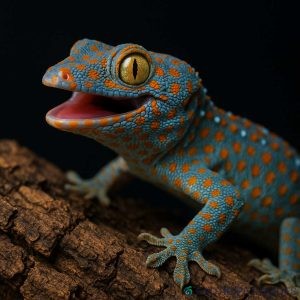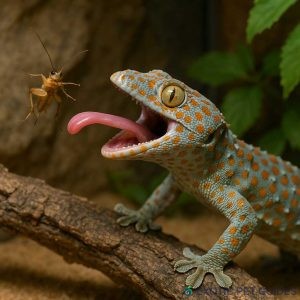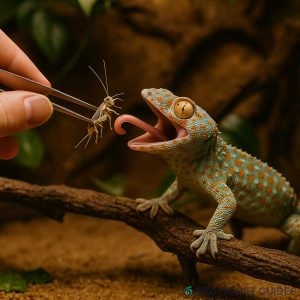🧭 Introduction
Tokay Geckos (Gekko gecko) are one of the most striking and misunderstood reptiles in the pet world. With their:
- Bright blue-gray bodies
- Bold orange spots
- Loud “To-kay! To-kay!” call
…they’re hard to ignore.
But — they also have a reputation for being feisty and hard to handle.
In this beginner’s guide, we’ll help you decide if a Tokay Gecko is right for you and cover the basics of their care.

🧬 Basic Facts
| Trait | Details |
|---|---|
| Scientific Name | Gekko gecko |
| Adult Size | 10–14 inches (25–35 cm) |
| Lifespan | 10–20 years in captivity |
| Origin | Southeast Asia |
| Activity | Nocturnal (active at night) |
| Temperament | Defensive, vocal, bold |

⚠️ Is a Tokay Gecko a Good Pet for Beginners?
It depends.
✅ They are:
- Visually stunning
- Hardy and resilient
- Fascinating to observe
❌ But they:
- Hate being handled (can bite hard!)
- Are fast and strong climbers
- Require precise humidity and heating
👉 If you want a pet to watch, not cuddle, a Tokay Gecko might be a great fit.

🏡 Enclosure Basics
Tokay Geckos are arboreal (tree dwellers), so vertical space is essential.
Enclosure Size
| Gecko Size | Recommended Tank |
|---|---|
| Juvenile | 12x12x18 inches (30x30x45 cm) |
| Adult | 18x18x24 inches or larger |

Lighting & Temperature
- UVB: Optional but recommended
- Basking temp: 85–90°F (29–32°C)
- Ambient temp: 75–82°F (24–28°C)
- Night temp: ≥70°F (21°C)
Use a thermostat-controlled heat source, and place thermometers at multiple levels.
💧 Humidity & Substrate
Tokay Geckos need high humidity between 60–80%.
Tips to Maintain Humidity:
- Daily misting (morning & night)
- Use substrate like coconut fiber, sphagnum moss, orchid bark
- Add live or fake plants

🍗 Diet: What Do Tokay Geckos Eat?
They’re insectivores, eating mostly:
- Crickets
- Dubia roaches
- Mealworms & superworms
- Occasional waxworms (treat)
Feed juveniles daily and adults every 2–3 days. Dust insects with calcium and multivitamin powder regularly.

🧤 Handling & Temperament
Handling Tip:
Don’t handle Tokays directly, especially early on.
Use tools like:
- Long feeding tongs
- Snake hook (for moving)
- Padded gloves if necessary
Over time, some individuals can tolerate gentle handling — but most remain defensive.

🧼 Cleaning & Maintenance
| Task | Frequency |
|---|---|
| Spot clean waste | Daily |
| Water change | Daily |
| Mist enclosure | 1–2x daily |
| Deep clean | Every 2–3 weeks |
✅ Pros & Cons Summary
Pros
✔ Stunning appearance
✔ Active and vocal
✔ Hardy and low feeding cost
Cons
✘ Can be aggressive
✘ Not handleable for most
✘ Needs strict humidity & climbing space